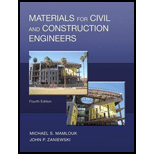
Concept explainers
A project specifies a concrete strength of at least 3000 psi. Materials engineers will design the mix for a strength higher than that. Calculate the required average compressive strength of the mix design if the standard deviation is s = 350 psi. Estimate the modulus of elasticity of the concrete at the required average compressive strength (the calculated strength, not the given strength).
Learn your wayIncludes step-by-step video

Chapter 7 Solutions
Materials for Civil and Construction Engineers (4th Edition)
Additional Engineering Textbook Solutions
Foundation Design: Principles and Practices (3rd Edition)
Mechanics of Materials (10th Edition)
Starting Out with Java: From Control Structures through Data Structures (3rd Edition)
Artificial Intelligence: A Modern Approach
Starting Out with C++: Early Objects (9th Edition)
Starting out with Visual C# (4th Edition)
- Calculate the modulus of elasticity Ec of lightweight concrete that has a unit weight of 110 pcf and compare it to the modulus of elasticity Ec of a normal weight concrete. Both concretes have compressive strengths (f’c) of 4000 psi. Express the solutions in psi units. Please also explain why the values are different.arrow_forwardQ. Using the British methods, design a concrete mix to bear an average compressive strength of 35 MPa at 28 days, to cast a room slab with the following dimensions (5 width x 4 length x 0.2 depth m) and 200 mm space distance of reinforcement. Consider the following properties: o Cement used is type I Portland cement ® Required slump = 30 — 60 mm o Coarse aggregate: ® Crushed rocks * Maximum size of 40 mm, e The fine aggregate: * Crushed rocks = Falls in zone 3 o Assume zone A for figure 1 o AssumeK = 1.64arrow_forwardcompute for the corrected amount of water needed in the concrete mix if the mass and fine coarse aggregates are 740 kg and 1100 kg, and both have a natural moisture content of 2% and 1.5% respectively. water/cement ratio is 0.5 and the mass of ratio of concrete is 1:2:3arrow_forward
- A concrete mix design uses coarse aggregates with NMAS of 19 mm. Fineness modulus of 2.8 and DRUW of 135 lb/ft^3. What is the mass of Coarse aggregates in the mix?arrow_forwardA hollow concrete masonry unit has actual gross dimensions of 190 mm * 190 mm* 390 mm (width * height * length). The unit is tested in a compression machine with the following results: Failure Load = 1110 kN Net volume of 6 * 106 mm3 a. Calculate the gross area compressive strength. b. Calculate the net area compressive strength.arrow_forwardDesign the concrete mix according to the following conditions:Design EnvironmentBuilding frameRequired design strength = 27.6 MPaMinimum dimension = 150 mmMinimum space between rebar = 40 mmMinimum cover over rebar = 40 mmStatistical data indicate a standard deviation of compressive strength of2.1 MPa is expected (more than 30 samples).Only air entrainer is allowed.Available MaterialsAir entrainer: Manufacture specification 6.3 mL/1% air/100 kg cement.Coarse aggregate: 19 mm nominal maximum size, river gravel (rounded)Bulk oven-dry specific gravity = 2.55, absorption = 3.6,Oven-dry rodded density = 1761 kg/m3Moisture content = 2.5,Fine aggregate: Natural sandBulk oven-dry specific gravity = 2.659, absorption = 0.5,Moisture content = 2,Fineness modulus = 2.47arrow_forward
- You are assigned to monitor the concrete strength gain at a construction site. The ultimate compressive strength of the concrete at its full maturity is 450 kg/m. The average concrete temperature at the construction site is 25 °C during the day and 15 °C during the night (assuming 12-hour day/night cycles). If you assume that the datum temperature (To) is - 10 °C, estimate the strength of concrete after 14 days. (4=35, B=51)Maturity Index, M = E(T - To).arrow_forwardWhat is the maximum aggregate size that can be used in concrete for the following conditions:arrow_forwardIn proportioning a concrete mix, the coarse and fine aggregates had the following properties respectively; Coarse: Dry weight: 800lb, 3,2% MC, 2.0% AC, Fine: Dry weight 350 lb, 1.2% MC, 2.9% AC. How much should the water be adjusted to account for the agregate moisture?arrow_forward
- Three concrete mixes with the same ingredients, except the amount of mixing water, and their slump values were obtained. Three 150 mm * 300 mm concrete cylinders were prepared for each mix. The cylinders were cured for 7 days and then tested for compressive strength. The test results are as shown. Assume that the aggregate was at the saturated surface-dry condition before adding mixing water.It is required to do the following:a. Determine the compressive strength of each cylinder after 7 days.b. Determine the average compressive strength of each mix after 7 days.c. Determine the w/c ratio for each mix.arrow_forwardAs follows: 1- The reason for the decrease in concrete resistance when the temperature rises? 2- Reasons for preferring ready-mixed concrete over other types of concrete? 3- Why is it not preferred to mix concrete for a period of time more than required? 4- Why is adhesion between cement and aggregate paste more important in highly resistant concrete 5- Why is it important to get rid of the isolation phenomenon in soft concrete?arrow_forward6. Discuss the different types of volume change in concrete at early and long-term ages.arrow_forward

 Structural Analysis (10th Edition)Civil EngineeringISBN:9780134610672Author:Russell C. HibbelerPublisher:PEARSON
Structural Analysis (10th Edition)Civil EngineeringISBN:9780134610672Author:Russell C. HibbelerPublisher:PEARSON Principles of Foundation Engineering (MindTap Cou...Civil EngineeringISBN:9781337705028Author:Braja M. Das, Nagaratnam SivakuganPublisher:Cengage Learning
Principles of Foundation Engineering (MindTap Cou...Civil EngineeringISBN:9781337705028Author:Braja M. Das, Nagaratnam SivakuganPublisher:Cengage Learning Fundamentals of Structural AnalysisCivil EngineeringISBN:9780073398006Author:Kenneth M. Leet Emeritus, Chia-Ming Uang, Joel LanningPublisher:McGraw-Hill Education
Fundamentals of Structural AnalysisCivil EngineeringISBN:9780073398006Author:Kenneth M. Leet Emeritus, Chia-Ming Uang, Joel LanningPublisher:McGraw-Hill Education
 Traffic and Highway EngineeringCivil EngineeringISBN:9781305156241Author:Garber, Nicholas J.Publisher:Cengage Learning
Traffic and Highway EngineeringCivil EngineeringISBN:9781305156241Author:Garber, Nicholas J.Publisher:Cengage Learning





